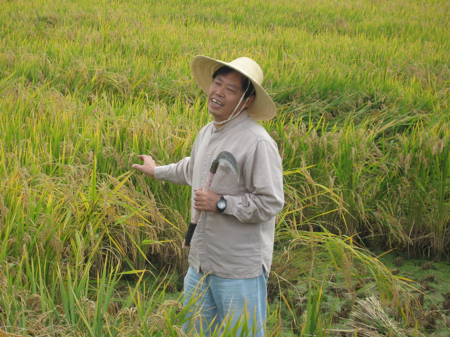There are links to a whole bunch of interesting stuff on “Why our food choices matter” on bookforum.com today.
More rice terrace wonders
Also at Yunnan Agricultural University I got a brief glimpse of some absolutely fascinating research from the Yuanyang rice terraces, which rival those of Banaue in age and extent. Professor Wang Yunyue, who just happens to be the wife of Professor Zhu, has been studying the agriculture of the Hani people who have cultivated the terraces for at least 1300 years. Modern hybrids have been introduced from time to time, but the Hani always abandon them after a couple of years, usually because they are no longer resistant to the diseases they were brought in to combat. Instead, the Hani continue to grow their traditional landraces.
DNA barcoding takes off
DNA barcoding is based on a gamble (or maybe a shrewd guess), and perhaps a smidgin of circular thinking: that there is a chunk of genome short enough to sequence quickly and cheaply, and which shows just enough variability for the entire sequence to be the same for all members of a species, but different for different species. Well, the gamble seems to have paid off. A suitable bit of a gene has duly been identified for both animals and plants, data are being ammassed, and there’s talk of a portable gadget being available in a few years which will read off the relevant sequence from a bit of leaf or skin or something and compare it with a database to give you the species name right there in the field.
Feet of clay

That’s another one to tick off the life list. Above you see Zhu Youyong, who describes himself as a farmer. He happens also to be Distinguished Professor Zhu, President of Yunnan Agricultural College and a hero of mine.
Zhu’s name is associated with a method of growing rice that delivers higher, more stable yields with lower inputs of fungicides and a more stable harvest from year to year. Not bad for an amazingly simple idea. The problem is that traditional landraces of sticky rice, which farmers like to grow and to eat, are susceptible to fungal disease. They also have a nasty tendency to fall over, or lodge, especially when they are carrying a bountiful load of seed. Modern hybrids are disease resistant, and high-yielding, but the taste is not much to write home about. Yields are high, but prices are low. To grow the tasty traditional landraces, farmers need to be able to afford fungicides and they need to be able to overcome their tendency to lodge.
Maintaining diversity: an experiment
When we talk about biodiversity — including agrobiodiversity — we really mean three things at the same time: diversity among ecosystems, among species, and within species. Scientists usually study these scales separately, but can diversity at one level somehow affect diversity at another? That’s the question tackled by an experiment described last week in Science 1 and discussed by one of the authors in Scitizen (fortunately, because the full paper is behind a paywall). 2